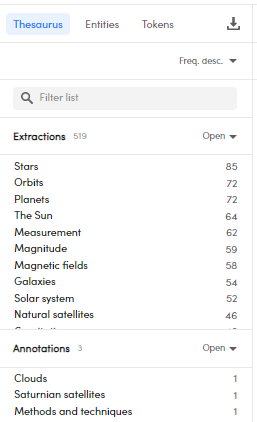The Documents tab
Below you will find the peculiarities of the Documents tab of the project dashboard of thesaurus projects.
The characteristics of the tab that are common to all project types are described in the article dedicated to the topic.
Detail view's central panel
In the default visualization of the detail view, the third bar from the top in the central panel shows buttons displaying:
- The number of extractions.
- The number of annotations.
- The number of true positives.
- The number of false positives.
- The number of false negatives.

The buttons also act as toggle switches: to toggle the highlight of all the extractions, annotations, true positives, etc., select the corresponding button.
You can select one or more of the first two buttons or one or more of the second three, but the two groups are mutually exclusive: if you select a button of one group, any buttons selected in the other group are deselected.
The Thesaurus tab
In list view
In list view, the Thesaurus tab is in the left panel.
Under Extractions you'll find the concepts that were detected during the last experiment, if any, or when the document were analyzed during the creation process after the definition of the initial taxonomy.
Under Annotations are listed the concepts that were annotated as expected results.

The numbers beside the Extractions and Annotations headings are, respectively, the number of distinct concepts that have been extracted and the number of distinct concepts that have been annotated in the current, possibly filtered, set of documents.
The number beside each concept under Extractions is the number of documents in the current list from which that concept was extracted. Similarly, the number beside each concepts under Annotations is the number of documents in which that concept was annotated.
- To filter the lists, type a value or the initial part of it in the Filter list box and press
Enter. The match is case sensitive. Select the X icon inside the box to cancel the filter. - To change the sort order, select the desired option from the drop-down menu at the top right of the list.
- Double-click an item to insert it in the search bar as criteria for document search.
If a list appears truncated, select Open beside its name to give the list maximum space. Select Close to revert to previous visualization.
- To switch to the Resources tab of the project dashboard and show the detail of a concept, hover over the class and select Show in resources
 .
. - To show more information about a concept, like concept relations, labels and hierarchy hover over it and select Show info
 . If the concept has a relation, select Show resources
. If the concept has a relation, select Show resources  to view it in the Resources tab.
to view it in the Resources tab. - To switch to the context view, hover over the concept and select Context view
 .
.
In detail view
The Thesaurus tab on the right of the detail view shows the concepts and the related annotations and extractions.
In case of a new project with no annotations and extractions, no details are available.
- To filter the lists, type a value or the initial part of it in the Filter list box and press
Enter. The match is case sensitive. Select the X icon inside the box to cancel the filter. - To change the sort order, select the desired option from the drop-down menu at the top right of the list.
- Double-click an item to insert it in the search bar as criteria for document search.
- To switch to the Resources tab of the project dashboard and show the detail of a concept, hover over the class and select Show in resources
 .
. - To show more information about a concept, like concept relations, labels and hierarchy hover over it and select Show info
 . If the concept has a relation, select Show resources
. If the concept has a relation, select Show resources  to view it in the Resources tab.
to view it in the Resources tab.
You can use this tab as a tool to annotate. More details in the dedicated page.
Change document language
If you chose a wrong language during the upload or you chose the language auto-detection option, but you don't agree with the choice made by the system, you can change the language of a document.
This can be done in the list view.
To change the language of a document:
- Choose the document from the list and then select Change language
 on the toolbar above the list.
on the toolbar above the list.
Or:
-
Select Change language, corresponding to the chip with the language code, in the document strip.

In both cases you can choose from all the supported languages of the technology version underlying the project.
To change the language of multiple documents, select them with Ctrl+Click then select Change language  on the toolbar above the list.
on the toolbar above the list.
Info
The language change operation requires the repetition of the linguistic-semantic analysis for affected documents and the reorganization of the document indexes, therefore it is carried out in the background and can take a considerable amount of time.
During the operation, affected documents are grayed out.
At the end of the operation, a notification appears inviting you to reload the corpus to see the effects of the change.